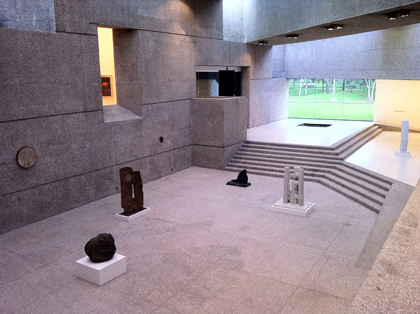El día del ojo
August 20th, 2012
Especially conceived for the Museo Tamayo, El día del ojo is a new work by Pierre Huyghe entailing research, travel and chance encounters across Mexico. It will be inaugurated next week, as part of the re-opening of this newly expanded and renovated museum. Pierre and I started discussions and work on this project in 2009, during my tenure as director of Museo Tamayo, and it’s a pleasure that it’s finally come into fruition.
The artist’s work consists of a water-filled pool inhabited by live, blind-cave fish and by floating volcanic rocks. It’s built in the museum’s indoor sculpture patio. Within that quasi-natural, quasi-artificial environment underground, these species are left on their own, without any other being bearing witness to them. This work, which is made invisible or visible at the museum according to rituals defined by the artist, will be uncovered by opening the floor… and will remain so until future yet undefined protocols create its disappearance.
To create this work, the artist sited natural phenomena and cultural manifestations that exist, but that are invisible or likely go unseen. Aside from this being insinuated formally through the work, this is also implicated in its title: El día del ojo. If the exhibition title was literally translated to the English, it would refer to a designated day for the warranted observance of the eye or simply of observing; if the translation was more openly interpreted, it would suggest, possibly, looking at the predicaments arising with eye witnessing.
Presented along with this live-sculpture by Huyghe are a number of artifacts and sculptures, all made of minerals and drawn from the collections of the Museo Tamayo and the Museo de Arte Prehispánico in Oaxaca City, both institutions founded by the artist Rufino Tamayo. The placement of these objects in the sculpture patio is determined by the sunlight radiating through the building skylights and cast on its grounds at specific hours. And, their presentation calls on the display that Huyghe experienced on his first visit to Museo Tamayo in 1987. However, it is far from a reconstruction of the exhibition that Huyghe witnessed at that time, and that he captured others seeing with this own film camera twenty-five years ago. Instead, it is an attempt to reverse the condition of encounter: from exhibiting something to being exposed to something.
One more component in a multiple set of operations that constitute El día del ojo is a publication on Huyghe’s journeys and encounters in Mexico. Neither a visual essay nor a travelogue, it includes a text that I penned preceded by images of the Museo Tamayo’s 1987 exhibition drawn from the artist’s personal film-reels; pictures from his journey to the Naica Caves in northern Chihuahua, and; several other points of interest that were unearthed from caves to archives in the process of creating this work.
Huyghe’s El día del ojo—the work and its opening rituals, the presentation determined by a sun-clock, and the accompanying publication—attempts to either expand or constrict the sense of time between what exists in itself and what appears to the eye. In doing so, it is an invitation to reconsider the spaces of interpretation that reminiscences and oblivion create as the place of the unknown. In between all that, the figure of the witness is observed.
Pierre Huyghe’s El día del ojo opens to the public on August 26, 2012 at Museo Tamayo in Mexico City. El día del ojo is commissioned by Museo Tamayo; Sofía Hernández Chong Cuy, curator; Daniela Pérez, project coordinator; Melissa Dubbin, producer; key collaborators include the biologist Víctor Hugo Reynoso and architect Juan Carlos Garduño.
You can skip to the end and leave a response. Pinging is currently not allowed.
Leave a Reply